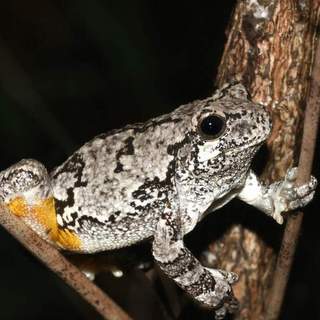Cope’s and Eastern Gray Treefrogs
Overview:
Scientific Name: Hyla chrysoscelis/versicolor
Size: 1.2 – 2.4” (adult lengt
Status: Common throughout most of their range.

Habitat:
Found in deciduous or mixed forests, farm woodlots, swamps, old fields, and well-vegetated yards or suburban areas. Will inhabit areas where suitable breeding ponds are located near trees or shrubs.
Adult Coloration:
Coloration variable, and individuals have the ability to change color within one or more hours. Background color is usually gray (may be almost whitish), brown, or pale brown, with one or more dark blotches often outlined in black on the back. Dark stripe or band often extends from eye to front leg. Often white square blotch occurs beneath each eye. Belly white, and inner thighs and groin is bright yellow or orange.
Adult Characteristics:
Skin is warty and moist. Toepads large, rounded, and adhesive. Males are a bit smaller than females, and have a vocal sac apparent by loose grayish skin in the throat. Voice: The calls of these two species is the main distinguishing characteristic. The Eastern Gray Treefrog (H. versicolor) has a loud, musical trill lasting from ½ to 3 seconds, while the Cope’s Grey Treefrog (H. chrysoscelis) has a faster, harsher, more nasal trill. Since temperature can affect the duration and frequency (pulse rate) of the call, it is difficult to identify the species in a monospecific chorus. e.g., for each species individually see: http://www.youtube.com/watch?v=hoh6VDcZmco&feature=BFa&list=UUQBXHFI3kPpoaMR_6GAmfaw, http://www.youtube.com/watch?v=rFrgNZHbBuU, and to compare in a multi-species chorus, see: http://www.youtube.com/watch?v=2k5CTLNw04w&list=UUQBXHFI3kPpoaMR_6GAmfaw&index=10&feature=plcp
Juvenile Characteristics:
Metamorphs are usually bright green without a lot of marking on the back.
Larvae Characteristics:
Tadpoles are greenish or yellowish on the back with gold flecks or streaks. Belly is whitish. Tail fins are relatively highly arched, and usually tinged with red or orange, and sometimes with black spots on the edges.
Species Confused With:
These species are unlikely to be confused with others. Northern Spring Peepers are much smaller and lack yellow inner thighs. The trill of the American Toad is somewhat similar, but lasts considerably longer (6 – 30 seconds). The “warning” trill of the Spring Peeper is almost always preceded or followed by a few short “peeps.”
References:
- Amphibians and Reptiles of the Great Lakes Region by Jim Harding
- Harding, J.H. and J.A. Holman. 1992. Michigan Frogs, Toads, and Salamanders. MSU Cooperative Extension Service and MSU Museum. Extension Bull. E-2350, 144 pp.
- Ruthven, A. G., H. B. T. Gaige, et al. 1912. The herpetology of Michigan, by Alexander B. Ruthven. Crystal Thompson and Helen Thompson; Memoranda towards a bibliography of the archaeology of Michigan, by Harlan I. Smith; prepared under the direction of Alexander G. Ruthven. Lansing, Mich., Wynkoop Hallenbeck Crawford, State Printers.
- Holman, J. A. 2012. The Amphibians and Reptiles of Michigan: A Quaternary and Recent Faunal Adventure. Detroit, Mich., Wayne State University Press.
- Conant, R., and Collins, J. T. 1998. Reptiles and Amphibians: Eastern, Central North America. Houghton Mifflin Harcourt Press.
